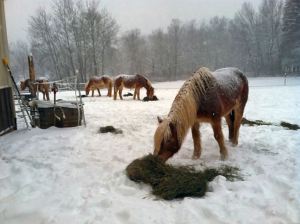You have to wonder which is worse, the deep snow or the gusting winds that are bringing the temperature below 00 and the wind chill into the -30s. We can bundle up, but what about our fur kids – the horses.
With over ten years’ experience, you would think I wouldn’t worry any more. But I do. Even though I know that our horses have enough to eat and warm water to drink and shelter. I still can’t help being concerned even though I know how the metabolism of the horse works.

Good feed
Hay is the best feed for horses, especially during the cold winter months. When the hay is digested in the hindgut, it ferments and keeps the horse warm. Increase hay as the temperature drops below freezing. Consult your vet to determine the optimal amount of hay for your horse. Older horses and working horses may require more hay than easy keepers or pasture ornaments. If you can keep hay in front of your horse at all times, that would be perfect. But some horses would gorge themselves, so this is not a wise choice.
Plenty of water
Even in the winter the horse needs a good source of palatable water to prevent colic. Water heaters work good in large tanks and heated buckets work in stalls. If the water is too warm, your horse may not drink it. Also make sure the heater is grounded. Your horse will refuse to drink if it gets a shock from the water bucket.
Nature’s insulation
Most horses put on a thick coat for the winter. But did you ever wonder if it is thick enough? Do you ever shiver and get goose bumps? So do horses. Shivering – not excessively – can help boost the metabolism and help warm the horse up. More effective is piloerection. When you get goose bumps, your skin contracts and little bumps appear causing your hair to stand on end. The same thing happens with the horse, but, this fluffs their coat. They can actually control how “fluffy” their coat gets and the air space between the hair helps to insulate them against the cold. A healthy horse will have a “blanket of snow” on their backs and not be wet at all.
Moving the blood
But what about their hooves, ears, muzzle? The horse has a capillary system that can direct the blood to and from different parts of the body. So, in the summer, the thermoregulatory system directs the blood away from the organs and toward the skin to relieve the body of heat. It also directs the blood in a way to cool the hooves, ears, and muzzle. In the winter, the opposite happens and the blood warms these areas.
Knowing all of this, I will still check on the horses regularly, making sure they have a good supply of hay and a filled, warm water trough. Then go back to the house for a cup of hot chocolate, since my body could learn something from the horse’s metabolism.
Leave a comment